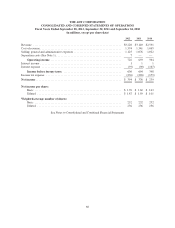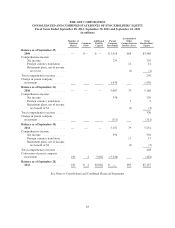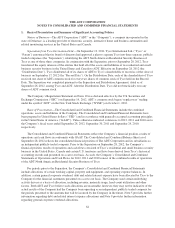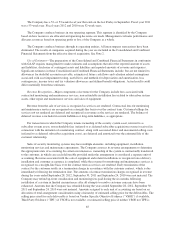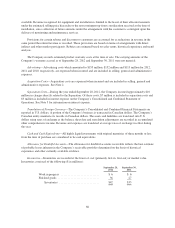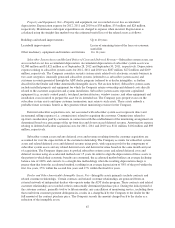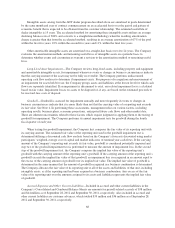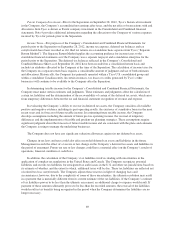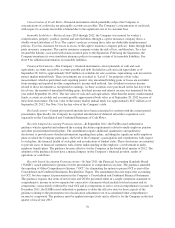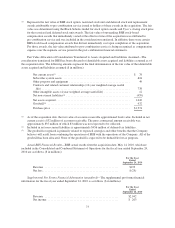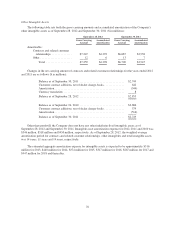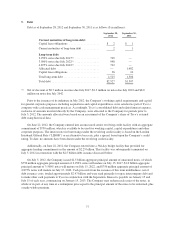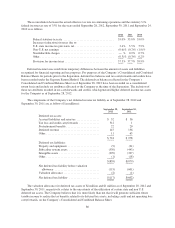ADT 2012 Annual Report Download - page 162
Download and view the complete annual report
Please find page 162 of the 2012 ADT annual report below. You can navigate through the pages in the report by either clicking on the pages listed below, or by using the keyword search tool below to find specific information within the annual report.Concentration of Credit Risks—Financial instruments which potentially subject the Company to
concentrations of credit risks are principally accounts receivables. The Company’s concentration of credit risk
with respect to accounts receivable is limited due to the significant size of its customer base.
Insurable Liabilities—For fiscal years 2010 through 2012, the Company was insured for worker’s
compensation, property, product, general and auto liabilities through a captive insurance company that is a
wholly owned subsidiary of Tyco. The captive’s policies covering these risks are deductible reimbursement
policies. Tyco has insurance for losses in excess of the captive insurance company policies’ limits through third
party insurance companies. The captive insurance company retains the risk of loss, and therefore, Tyco has
retained the liability associated with claims incurred prior to the Separation. Following the Separation, the
Company maintains its own standalone insurance policies to manage certain of its insurable liabilities. See
Note 9 for additional information on insurable liabilities.
Financial Instruments—The Company’s financial instruments consist primarily of cash and cash
equivalents, accounts receivable, accounts payable and debt. Included in cash and cash equivalents as of
September 28, 2012 is approximately $187 million of available-for sale securities, representing cash invested in
money market mutual funds. These investments are classified as “Level 1” for purposes of fair value
measurement, which is performed each reporting period. Any unrealized holding gains or losses are excluded
from earnings and reported in other comprehensive income until realized. Any dividend or interest income
related to these investments is recognized in earnings. As these securities were purchased on the last day of the
fiscal year, the amount of unrealized holding gains, dividend income and interest income was immaterial for the
year ended September 28, 2012. The fair value of cash and cash equivalents, other than the money market mutual
funds, accounts receivable and accounts payable approximated book value as of September 28, 2012 because of
their short-term nature. The fair value of the money market mutual funds was approximately $187 million as of
September 28, 2012. See Note 5 for the fair value of the Company’s debt.
Reclassifications—Certain prior period amounts have been reclassified to conform with the current period
presentation. Specifically, the Company has reported amortization of deferred subscriber acquisition costs
separately on the Consolidated and Combined Statements of Cash Flows.
Recently Adopted Accounting Pronouncements—In September 2011, the FASB issued authoritative
guidance which expanded and enhanced the existing disclosure requirements related to multi-employer pension
and other postretirement benefit plans. The amendments require additional quantitative and qualitative
disclosures to provide more detailed information regarding these plans, including the significant multi-employer
plans in which the Company participates, the level of the Company’s participation and contributions with respect
to such plans, the financial health of such plans and an indication of funded status. These disclosures are intended
to provide users of financial statements with a better understanding of the employer’s involvement in multi-
employer benefit plans. The guidance became effective for the Company in the fourth fiscal quarter of 2012. The
adoption of the guidance did not have a material impact on the Company’s financial position, results of
operations or cash flows.
Recently Issued Accounting Pronouncements—In June 2011, the Financial Accounting Standards Board
(“FASB”) issued authoritative guidance for the presentation of comprehensive income. The guidance amended
the reporting of Other Comprehensive Income (“OCI”) by eliminating the option to present OCI as part of the
Consolidated and Combined Statements Stockholders’ Equity. The amendment does not impact the accounting
for OCI, but does impact its presentation in the Company’s Consolidated and Combined Financial Statements.
The guidance requires that items of net income and OCI be presented either in a single continuous statement of
comprehensive income or in two separate but consecutive statements which include total net income and its
components, consecutively followed by total OCI and its components to arrive at total comprehensive income. In
December 2011, the FASB issued authoritative guidance to defer the effective date for those aspects of the
guidance relating to the presentation of reclassification adjustments out of accumulated other comprehensive
income by component. The guidance must be applied retrospectively and is effective for the Company in the first
quarter of fiscal year 2013.
70


